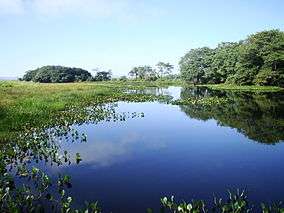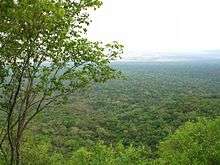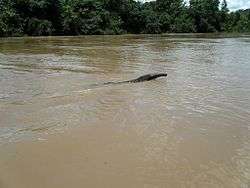Trinational Biodiversity Corridor
The Trinational Biodiversity Corridor (Portuguese: Corredor Trinacional de Biodiversidade) is a proposed ecological corridor that would link protected areas in the Alto Paraná Atlantic forests biome in Brazil, Paraguay and Argentina.
| Trinational Biodiversity Corridor | |
|---|---|
| Corredor Trinacional de Biodiversidade | |
The Iguazu Falls are in the center of the proposed corridor | |
 | |
| Coordinates | 25.592344°S 54.593522°W |
| Area | 570,000 hectares (1,400,000 acres) |
| Designation | Ecological corridor |
History
The proposed corridor was first discussed in 1999 in the Symposium on Research and Biodiversity in Umuarama, PR. The idea was refined later that year at the 3rd Workshop on Traditional Initiative and Sustainable Use of Inland Atlantic Forest in Misiones, Argentina.[1] The Trinational Green Corridor Initiative was established in 1999 with elected national representatives of the protected areas, national and international community and private business conservation organizations, rural development and community organizations and representatives of international organizations and scientific institutions. The purpose was to assist the many players involved in using and managing the natural resources of the Parana Forest region to work together.[2]
In 2000 the meeting organized by the World Wide Fund for Nature (WWF) and the Atlantic Forest NGO Network established the final design. The corridor would encompass conservation units in Brazil, Paraguay and Argentina in the Upper Paraná ecoregion. The concept was that the institutions responsible for these units would work together on a medium to long term plan to connect the units by gradually restoring native vegetation in small regional corridors. The units alone would total 570,000 hectares (1,400,000 acres).[1] The Trinational Commission on the Interior Atlantic Forest and the Green Corridor Initiative was set up to address action plans developed at various workshops in the early 2000s. The members were one representative from each national commission, a representative from the WWF and a representative from the International Union for Conservation of Nature (IUCN).[3]
WWF has been helping develop a joint strategy for the corridor, and in 2014 partnered with the Inter-American Development Bank (IDB) to develop benchmark studies of transboundary parks, and of the Iguaçu National Park in particular.[4] In July 2014 the IDB approved funding for the Iguaçu National Park in Brazil to include activities based on Biodiversity and Ecosystem Services (BES) to counter deforestation drivers in the area, with a view to expanding the approach to conservation units in Argentina and Paraguay.[5]
Challenges
Creation of the corridor has been delayed by lack of interest or resistance from the Brazilian government, mainly the Ministry of Foreign Affairs, which does not want to formally recognize a management space on the border between Brazil and other countries.[6] The concept also faces local opposition. In October 2003 about 300 people with bulldozers invaded the Iguaçu National Park in an attempt to reopen the "Estrada do Colono" (Colonists' Road), which had been closed two years earlier because it divided the park in two and threatened the park's biological integrity. Dividing the park would in turn divide the corridor.[7]
Related initiatives

The Green Corridor Law was enacted in Argentina in 1999 to provide for conservation of the natural heritage of the Misiones province. The Trinational Initiative would use this area as a core but expand it to cover sites such as Brazil's Iguaçu National Park and Turvo State Park beside Moconá Falls, and Paraguay's Moisés Bertoni Reserve.[8] The Paraná River Biodiversity Corridor aims to promote integrated environmental management between the conservation units in the Brazilian portion of the Paraná River basin, in the Guarani Aquifer recharge area. It maintains an interface with the Trinational Biodiversity Corridor.[9]
Extent
A large, continuous expanse of forest is needed to avoid genetic erosion of large mammals such as the jaguar, giant anteater and tapir, and birds such as the harpy eagle, parrots, macaws, toucans and hummingbirds that live in the forest.[10] The tri-national corridor will provide a forest connection to maintain and restore biodiversity and ecological health in two natural World Heritage Sites, two UNESCO Biosphere Reserves, two national parks, and a number of provincial parks and private reserves.[7] The Trinational Corridor will extend from the Morro do Diabo State Park in São Paulo state to the north to the Turvo State Park in Rio Grande do Sul state in the south. It may be possible to take a metapopulation approach to managing jaguars in the region.[11]
The conservation units in the proposed corridor as of 2007 would be:[12]
Notes
- Araújo Corte & Valladares-Pádua 2007, p. 21.
- Leal & Câmara 2003, p. 229.
- Leal & Câmara 2003, p. 335.
- WWF-Brasil expands conservation efforts ...
- BR-T1307 : Conservation of BES ...
- Corredor Trinacional é tema de reunião no Paraná.
- Bonello 2003.
- Leal & Câmara 2003, p. 262.
- Corredor de Biodiversidade do rio Paraná – CORIPA.
- Leal & Câmara 2003, p. 264.
- Crawshaw et al. 2012, p. 284.
- Araújo Corte & Valladares-Pádua 2007, p. 23.
Sources
- Araújo Corte, Dione Angélica de; Valladares-Pádua, Cláudio Benedito (November 2007), Plano de Manejo da Estação Ecológica Mico-Leão-Preto (PDF) (in Portuguese), Brasília: ICMBio, retrieved 2016-11-07
- Bonello, Jenna (9 October 2003), Iguacu National Park Under Threat Again, WWF, retrieved 2016-11-08
- BR-T1307 : Conservation of BES in the Atlantic Forest Tri-National Corridor of Iguazu National Park, IADB, retrieved 2016-11-08
- Corredor de Biodiversidade do rio Paraná (in Portuguese), CORIPA: Consórcio Intermunicipal Para Conservação do Remanescente do Rio Paraná e Áreas de Influência, retrieved 2016-11-11
- Corredor Trinacional é tema de reunião no Paraná (in Portuguese), Instituto Curicaca, retrieved 2016-11-11
- Crawshaw, Peter G., Jr.; Mahler, Jan K.; Indrusiak, Cibele; Cavalcanti, Sandra M.C.; Leite-Pitman, Maria Renata P.; Silvius, Kirsten M. (2012-05-29), "Ecology and Concervation of the Jaguar (Panthera onca) in Iguacu National Park, Brazil", People in Nature: Wildlife Conservation in South and Central America, Columbia University Press, ISBN 978-0-231-50208-5, retrieved 2016-11-08
- Leal, Carlos Galindo; Câmara, Ibsen de Gusmão (2003), The Atlantic Forest of South America: Biodiversity Status, Threats, and Outlook, Island Press, ISBN 978-1-55963-989-7, retrieved 2016-11-08
- WWF-Brasil expands conservation efforts through a project that creates a tri-national biodiversity corridor, 29 August 2014, retrieved 2016-11-08

